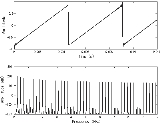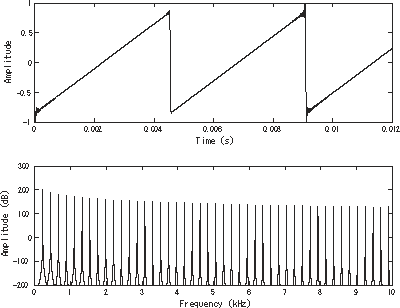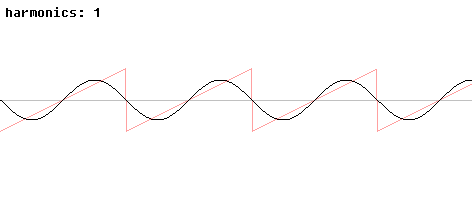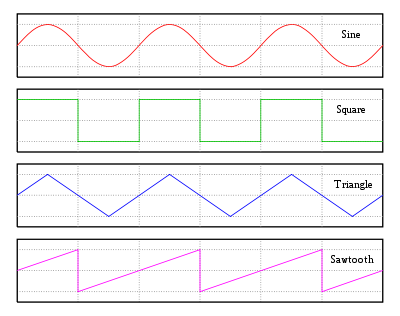
Sawtooth wave
Encyclopedia

Non-sinusoidal waveform
Non-sinusoidal waveforms are waveforms that are not pure sine waves. They are usually derived from simple math functions. While a pure sine consists of a single frequency, non-sinusoidal waveforms can be described as containing multiple sine waves of different frequencies. These "component" sine...
. It is named a sawtooth based on its resemblance to the teeth on the blade of a saw
Saw
A saw is a tool that uses a hard blade or wire with an abrasive edge to cut through softer materials. The cutting edge of a saw is either a serrated blade or an abrasive...
.
The convention is that a sawtooth wave ramps upward and then sharply drops. However, there are also sawtooth waves in which the wave ramps downward and then sharply rises. The latter type of sawtooth wave is called a "reverse sawtooth wave" or "inverse sawtooth wave".
The piecewise linear function

based on the floor function
Floor function
In mathematics and computer science, the floor and ceiling functions map a real number to the largest previous or the smallest following integer, respectively...
of time t is an example of a sawtooth wave with period 1.
A more general form, in the range −1 to 1, and with period a, is


This sawtooth function has the same phase
Phase (waves)
Phase in waves is the fraction of a wave cycle which has elapsed relative to an arbitrary point.-Formula:The phase of an oscillation or wave refers to a sinusoidal function such as the following:...
as the sine function.
A sawtooth wave's sound is harsh and clear and its spectrum contains both even and odd harmonic
Harmonic
A harmonic of a wave is a component frequency of the signal that is an integer multiple of the fundamental frequency, i.e. if the fundamental frequency is f, the harmonics have frequencies 2f, 3f, 4f, . . . etc. The harmonics have the property that they are all periodic at the fundamental...
s of the fundamental frequency
Fundamental frequency
The fundamental frequency, often referred to simply as the fundamental and abbreviated f0, is defined as the lowest frequency of a periodic waveform. In terms of a superposition of sinusoids The fundamental frequency, often referred to simply as the fundamental and abbreviated f0, is defined as the...
. Because it contains all the integer harmonics, it is one of the best waveforms to use for synthesizing musical sounds, particularly bowed string instruments like violins and cellos, using subtractive synthesis
Subtractive synthesis
Subtractive synthesis is a method of sound synthesis in which partials of an audio signal are attenuated by a filter to alter the timbre of the sound...
.
A sawtooth can be constructed using additive synthesis
Additive synthesis
Additive synthesis is a technique of sound synthesis that creates musical timbre by explicitly adding sinusoidal overtones together.The timbre of an instrument is composed of multiple harmonic or inharmonic partials , of different frequencies and amplitudes, that change over time...
. The infinite Fourier series
Fourier series
In mathematics, a Fourier series decomposes periodic functions or periodic signals into the sum of a set of simple oscillating functions, namely sines and cosines...
converges to an inverse sawtooth wave. A conventional sawtooth can be constructed using
In digital
Digital
A digital system is a data technology that uses discrete values. By contrast, non-digital systems use a continuous range of values to represent information...
synthesis, these series are only summed over k such that the highest harmonic, Nmax, is less than the Nyquist frequency
Nyquist frequency
The Nyquist frequency, named after the Swedish-American engineer Harry Nyquist or the Nyquist–Shannon sampling theorem, is half the sampling frequency of a discrete signal processing system...
(half the sampling frequency). This summation can generally be more efficiently calculated with a fast Fourier transform
Fast Fourier transform
A fast Fourier transform is an efficient algorithm to compute the discrete Fourier transform and its inverse. "The FFT has been called the most important numerical algorithm of our lifetime ." There are many distinct FFT algorithms involving a wide range of mathematics, from simple...
. If the waveform is digitally created directly in the time domain using a non-bandlimited
Bandlimited
Bandlimiting is the limiting of a deterministic or stochastic signal's Fourier transform or power spectral density to zero above a certain finite frequency...
form, such as y = x - floor
Floor function
In mathematics and computer science, the floor and ceiling functions map a real number to the largest previous or the smallest following integer, respectively...
(x), infinite harmonics are sampled and the resulting tone contains aliasing
Aliasing
In signal processing and related disciplines, aliasing refers to an effect that causes different signals to become indistinguishable when sampled...
distortion.

Applications
- Sawtooth waves are perhaps best known for their use in music. The sawtooth and square waves are the most common starting points used to create sounds with subtractive analogSubtractive synthesisSubtractive synthesis is a method of sound synthesis in which partials of an audio signal are attenuated by a filter to alter the timbre of the sound...
and virtual analog music synthesizers. - The sawtooth wave is the form of the vertical and horizontal deflectionDeflection (physics)In physics deflection is the event where an object collides and bounces against a plane surface.In such collisions involving a sphere and a plane, the collision angle formed with the surface normal must equal the bounce angle , \alpha = \beta.Magnetic deflection refers to Lorentz forces acting...
signals used to generate a rasterRaster graphicsIn computer graphics, a raster graphics image, or bitmap, is a data structure representing a generally rectangular grid of pixels, or points of color, viewable via a monitor, paper, or other display medium...
on CRTCathode ray tubeThe cathode ray tube is a vacuum tube containing an electron gun and a fluorescent screen used to view images. It has a means to accelerate and deflect the electron beam onto the fluorescent screen to create the images. The image may represent electrical waveforms , pictures , radar targets and...
-based television or monitor screens. OscilloscopeOscilloscopeAn oscilloscope is a type of electronic test instrument that allows observation of constantly varying signal voltages, usually as a two-dimensional graph of one or more electrical potential differences using the vertical or 'Y' axis, plotted as a function of time,...
s also use a sawtooth wave for their horizontal deflection, though they typically use electrostatic deflection.- On the wave's "ramp", the magnetic field produced by the deflection yoke drags the electronElectronThe electron is a subatomic particle with a negative elementary electric charge. It has no known components or substructure; in other words, it is generally thought to be an elementary particle. An electron has a mass that is approximately 1/1836 that of the proton...
beam across the face of the CRT, creating a scan lineScan lineA scan line or scanline is one line, or row, in a raster scanning pattern, such as a line of video on a cathode ray tube display of a television set or computer monitor....
. - On the wave's "cliff", the magnetic field suddenly collapses, causing the electron beam to return to its resting position as quickly as possible.
- The voltage applied to the deflection yoke is adjusted by various means (transformers, capacitors, center-tapped windings) so that the half-way voltage on the sawtooth's cliff is at the zero mark, meaning that a negative voltage will cause deflection in one direction, and a positive voltage deflection in the other; thus, a center-mounted deflection yoke can use the whole screen area to depict a trace. Frequency is 15.734 kHz on NTSCNTSCNTSC, named for the National Television System Committee, is the analog television system that is used in most of North America, most of South America , Burma, South Korea, Taiwan, Japan, the Philippines, and some Pacific island nations and territories .Most countries using the NTSC standard, as...
, 15.625 kHz for PALPALPAL, short for Phase Alternating Line, is an analogue television colour encoding system used in broadcast television systems in many countries. Other common analogue television systems are NTSC and SECAM. This page primarily discusses the PAL colour encoding system...
and SECAMSECAMSECAM, also written SÉCAM , is an analog color television system first used in France....
). - The vertical deflection system operates the same way as the horizontal, though at a much lower frequency (59.94 Hz on NTSCNTSCNTSC, named for the National Television System Committee, is the analog television system that is used in most of North America, most of South America , Burma, South Korea, Taiwan, Japan, the Philippines, and some Pacific island nations and territories .Most countries using the NTSC standard, as...
, 50 Hz for PAL and SECAM). - The ramp portion of the wave must appear as a straight line. If otherwise, it indicates that the voltage isn't increasing linearly, and therefore that the magnetic field produced by the deflection yoke is not linear. As a result, the electron beam will accelerate during the non-linear portions. This would result in a television image "squished" in the direction of the non-linearity. Extreme cases will show marked brightness increases, since the electron beam spends more time on that side of the picture.
- The first television receivers had controls allowing users to adjust the picture's vertical or horizontal linearity. Such controls were not present on later sets as the stability of electronic components had improved.
- On the wave's "ramp", the magnetic field produced by the deflection yoke drags the electron
See also

- Sine waveSine waveThe sine wave or sinusoid is a mathematical function that describes a smooth repetitive oscillation. It occurs often in pure mathematics, as well as physics, signal processing, electrical engineering and many other fields...
- SoundSoundSound is a mechanical wave that is an oscillation of pressure transmitted through a solid, liquid, or gas, composed of frequencies within the range of hearing and of a level sufficiently strong to be heard, or the sensation stimulated in organs of hearing by such vibrations.-Propagation of...
- Square waveSquare waveA square wave is a kind of non-sinusoidal waveform, most typically encountered in electronics and signal processing. An ideal square wave alternates regularly and instantaneously between two levels...
- Triangle waveTriangle waveA triangle wave is a non-sinusoidal waveform named for its triangular shape.Like a square wave, the triangle wave contains only odd harmonics...
- WaveWaveIn physics, a wave is a disturbance that travels through space and time, accompanied by the transfer of energy.Waves travel and the wave motion transfers energy from one point to another, often with no permanent displacement of the particles of the medium—that is, with little or no associated mass...
- ZigzagZigzagA zigzag is a pattern made up of small corners at variable angles, though constant within the zigzag, tracing a path between two parallel lines; it can be described as both jagged and fairly regular....



